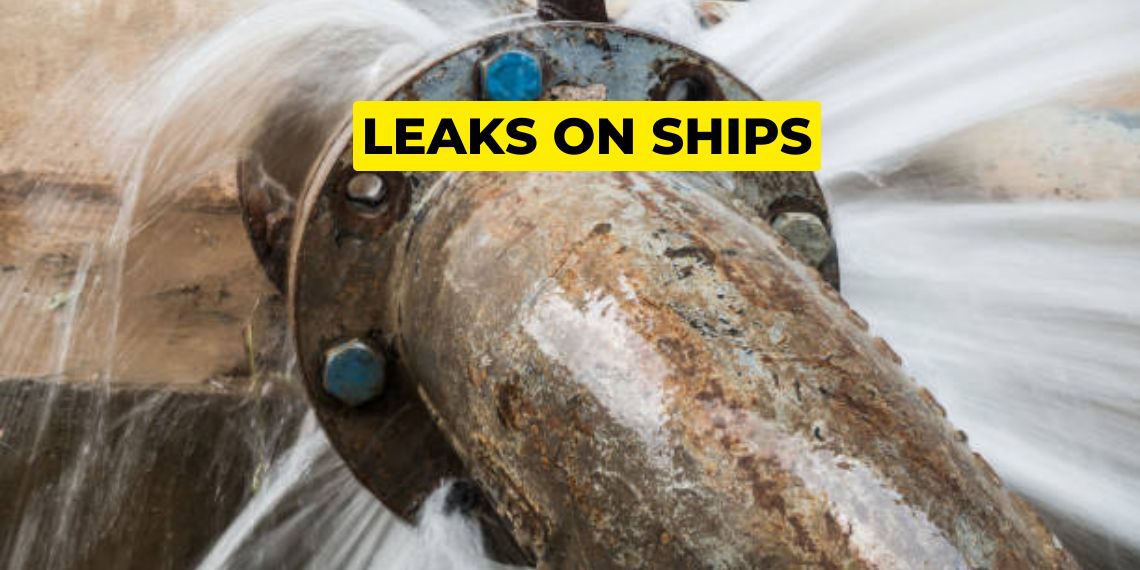Leak on ships
A leak is a small crack or holes through which the working fluid in the system can flow out of the intended path.

What are the dangers of leak on a ship?
- Fire : If a pipe containing oils were to leak, then the oil inside the pipe can fall down onto other surfaces and if these surfaces are hotspots then it will be very likely for a fire to occur.

2. Slipping and falling : If some fluid were to leak onto the part of the floor where the workers are walking through it can cause them to slip and in turn cause accidents.

3. Untidy workplace : If a leak is occurring at a certain location it is very likely for the place to get very dirty from all the working fluids.

How to identify leak on ships?
There are many different ways to identify leaks on a ship.
→Visually :
Sometimes you can visually observe if there are leaks present in the ship such as when you see water droplets falling from a certain point in the pipes.

→By sound :
When compressed air or steam is travelling through a pipe and a leak is present in the pipe, then when the fluid leaks out it will make a hissing sound which is easily identifiable and you can rectify the leak.

When the leaks are very small we cannot detect them visually or by listening to the leak and we will have to conduct different tests to identify the leak.
But even small leaks can turn into large leaks very quickly so we cannot be ignoring leaks of any size.
→Bubble Test
It is a method of finding small leaks in pipes which are carrying air. To do this test we must first prepare a lather solution by mixing water and detergent. If we place this solution on the part of the pipe which is suspected to be leaking, we can observe bubbles forming and popping in that area if a leak is present and there will be no reaction in the lather if a leak is not present.
So we can easily identify the area with the leak and rectify it.

→Pressure Test
If the pipe is too large for it to be feasible to do a bubble test then we will have to switch to other methods of leak detection.
(i)Using air(Pneumatic Pressure Testing)
One of the other methods to do this is to block off both sides of the pipe and to attach a pressure gauge to monitor the pressure inside the pipe. Then air is pumped into the pipe from one side until it reaches a set pressure. If there is a leak in the pipe the pressure in the pipe will decrease gradually and we can confirm the presence of a leak.
But if the leak is very small then filling the pipe with air will not be showing results as air is compressible and it will take a very long time for the pressure to reduce.
(ii)Using water(Hydrostatic Pressure Testing)
So instead water is used to fill up the pipe and compressed air is used to bring it up to the required pressure and then the pressure in the pipe is observed so see if there is a gradual decrease, we can also locate the area of the leak by checking for water droplets on the outside surface of the pipes.

Note:
If you want to learn more about this topic, we suggest checking out our Combo package with the given link https://merchantnavydecoded.com/courses/c/ . It’s a great way to dive deeper into the subject through video explanations. This package covers all the important details and presents them in an easy-to-understand format. Watching the videos will help you grasp the topic better and make learning more enjoyable. So, we highly recommend giving our Combo package a try to enhance your knowledge on the subject.
Disclaimer :- The opinions expressed in this article belong solely to the author and may not necessarily reflect those of Merchant Navy Decoded. We cannot guarantee the accuracy of the information provided and disclaim any responsibility for it. Data and visuals used are sourced from publicly available information and may not be authenticated by any regulatory body. Reviews and comments appearing on our blogs represent the opinions of individuals and do not necessarily reflect the views of Merchant Navy Decoded. We are not responsible for any loss or damage resulting from reliance on these reviews or comments.
Reproduction, copying, sharing, or use of the article or images in any form is strictly prohibited without prior permission from both the author and Merchant Navy Decoded.


